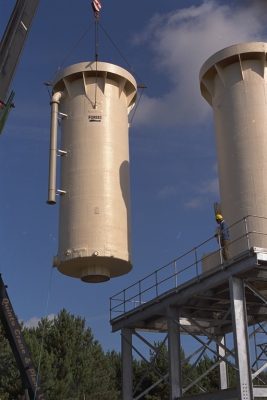Stripping Towers
Forbes stripping towers are designed for the efficient removal of Volatile Organic Contaminants (VOCs) from groundwater.
VOCs, once in the ground, can be present for a very long time. Even when they reach an aquifer, the speed of flow is often measured in just a few metres per year. Contamination may be found by chance in springs and wells or when dewatering construction sites. Or it may be surveyed and quantified when pollution, recent or long past, is known to have occurred.
The necessity for remediation is most immediate where a spring or well is needed for use, or where excavation water is too polluted to be disposed of without treatment.
Fast Response
Contamination problems are inherently urgent and Forbes can focus resources quickly by fast track management to meet emergency situations when required.
If necessary a pilot plant can be supplied to help determine a problem and the effect of stripping.
Key Information
- Efficient removal of Volatile Organic Compounds from groundwater
- Cost effective when compared to Carbon Adsorption
- Minimal maintenance costs
- Modest energy consumption
VOC Contamination
Relatively high levels of many organic contaminants can be reduced to well below WHO target levels by the stripping process which employs specially designed packed columns with new high-efficiency packing systems.
VOCs commonly found include halogenated hydro-carbons and aromatic compounds such as:
- Chlorinated Solvents
- Benzene
- Toluene
- Ethylbenzene and Zylene (BTEX compounds)
- Petroleum
- MTBE – Methyl Tertiary Butyl Ether
Many of these have been identified as carcinogens and regulations now restrict their presence in potable water supplies to ‘no discernable traces’.
An Economical Alternative to Carbon Adsorption
Air stripping is a highly cost-effective alternative to adsorption.
- Normally energy consumption is modest
- There are minimal maintenance costs in typical installations
- Stripping will typically reduce levels of 100mg’l to 5mg/l or below and the water can then be finally ‘polished’ with activated carbon
Activated carbon adsorption is a well established process to counter VOC contamination but the carbon is expensive and may need frequent regeneration.


